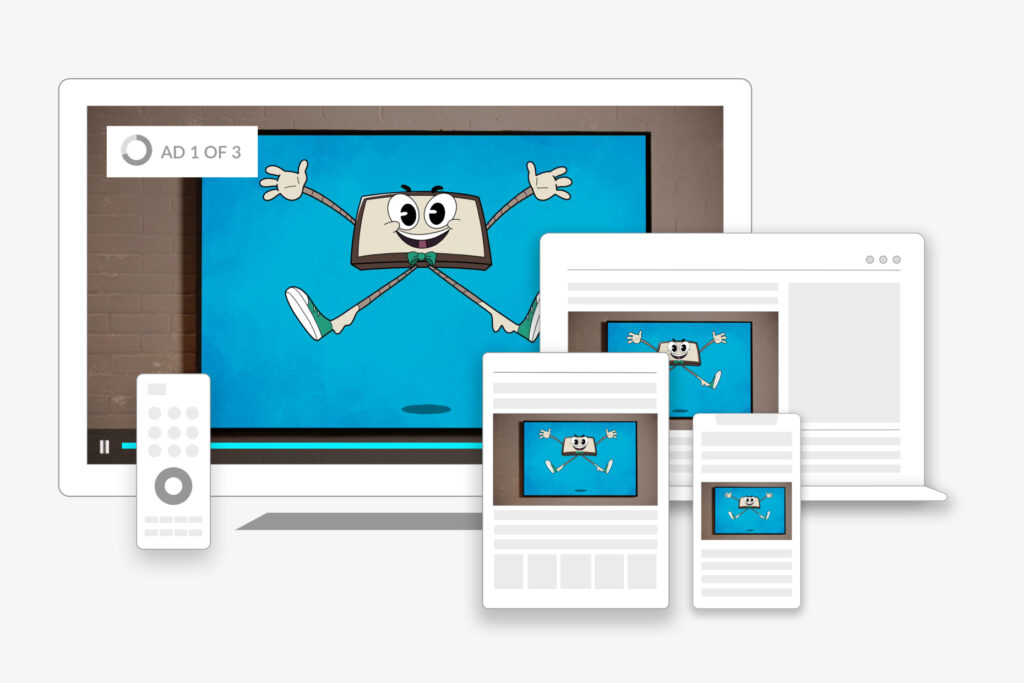MVPD (Multichannel Video Programming Distributor)
by The MNTN Team
7 Min Read
MNTN is the Hardest Working Software in Television. Get started today. Be on TV tomorrow.Learn More
This is your compendium of all things OTT advertising for 2025. From benefits and best practices to measuring campaign success, we’ve got you covered.

12 Min Read
Over-the-top (OTT) advertising isn’t the future—it’s the now. More people are cutting the cord and turning to streaming, and advertisers are following suit, shifting their budgets to meet audiences where they actually spend the most screen time. By 2025, U.S. ad spend on streaming TV is projected to surpass $30 billion, solidifying OTT as a must-have in any performance-driven marketing strategy.
But, simply appearing on streaming platforms isn’t enough. To win with OTT advertising platforms, you need more than a flashy ad—you need a smart, data-driven game plan. Think premium inventory, laser-focused targeting, and the kind of real-time tracking that tells you what’s working while it’s still happening.
This guide has everything you need to nail OTT advertising in 2025.
OTT (over-the-top) advertising delivers video ads directly to viewers over the internet—no cable box or satellite subscription is required. It runs on connected devices like smart TVs, streaming platforms, and mobile apps, helping brands reach audiences where they’re actively watching premium content.
Unlike the spray-and-pray approach of linear TV, OTT brings advanced targeting, real-time insights, and ROI you can actually measure. For marketers who live and breathe data, it’s a no-brainer.

Here’s the breakdown: OTT is the delivery system—the strategy powering streaming content over the internet. Connected TV? That’s the hardware—those internet-connected screens (usually a television set) where your ads land.
In other words, OTT is the playbook; CTV is the field you’re playing on.
VOD covers any content watched on-demand, whether it’s ad-supported or subscription-based, while OTT specifically refers to streaming content delivered over the internet. Every OTT ad is part of VOD, but not all VOD content includes OTT advertising.
OTT advertising is about reaching the right audiences, at the right time, with precision, impact, and measurable results. This is where linear TV falls short.
Here are a few other reasons why OTT ads should be in every modern marketing strategy.
OTT advertising uses real-time audience data—like interests, behaviors, and demographics—to put your message in front of high-value viewers. That targeting power translates into personalized ad experiences that drive stronger engagement and better results.
OTT viewers are more engaged and more likely to complete your ads, especially when the creative feels relevant and well-timed. Interactive formats and seamless integrations with content make brand interactions feel less like interruptions and more like invitations.
OTT advertising platforms provide built-in analytics that give you full visibility into performance, from impressions to conversions—no guesswork, just real results. With that real-time visibility, marketers can fine-tune strategy mid-flight and prove ROI without waiting on post-campaign reports.
The process of OTT marketing isn’t rocket science–it’s quite simple, really. Instead of buying traditional television advertising spots based on broad demographics, marketers use data-driven technology to serve ads to the right viewers at the right time.
Start by setting clear objectives—whether it’s brand awareness, site traffic, or conversions, your goals will shape your strategy. Then, use audience data to segment by demographics, behaviors, and viewing habits so your ads reach the right viewers from the start.
Not every streaming platform fits every brand, so select ones that align with your audience and content goals. Consider factors like audience scale, content quality, and ad capabilities across platforms like Hulu, Pluto TV, Peacock, and Disney+.
Build creative that’s not just polished but made to resonate with your audience in the context they’re watching. Choose ad formats—like pre-roll, mid-roll, or interactive—that match your objectives and blend naturally into the streaming experience.
Balance your media budget across platforms and formats for maximum reach and efficiency. Leverage programmatic buying and audience data to deliver ads to viewers most likely to take action.
Track real-time metrics like impressions, conversions, and ROAS to understand what’s working. Then, use those insights to refine creative, targeting, and spend—keeping your campaign optimized for performance every step of the way.
Not all streaming platforms operate the same way. OTT services follow different business models based on how they deliver content and generate revenue.
Here are the four main types:
Platforms like Netflix and Disney+ operate on a subscription-based model. In other words, in exchange for unlimited access to content, consumers agree to pay a monthly subscription cost.
Traditionally ad-free, some SVOD services now give the option of lower-cost, ad-supported tiers—giving advertisers a way to reach premium audiences.
AVOD platforms like Pluto TV, Tubi, and Freevee provide free content–you just have to watch a few ads. Since viewers opt-in to free ad-supported streaming television, platforms can provide brands with a high-reach, cost-effective way to advertise to those audiences.
Also known as pay-per-view, TVOD services like Apple TV and Google Play provide the ability for users to rent or buy individual movies and shows. While advertising opportunities are limited, brands can explore product placements (and sometimes partnerships) within premium content.
Think of this as upscale TVOD with a twist. Get access to early movie releases or exclusives at a premium price. Similar to TVOD, advertising options are limited, but sponsorships tied to big drops can be advantageous if you have the budget to do so.
OTT advertising isn’t one-size-fits-all. Different ad formats offer different levels of engagement, and knowing how they work can help marketers build more effective campaigns.
Here’s a breakdown of the main types:
OTT content isn’t tied to a single screen—viewers stream across multiple devices, and advertisers need to follow them wherever they watch. Understanding the different types of OTT devices helps marketers ensure their ads reach audiences in the right environment.
Here are the primary categories:
So, how do you reach these audiences? Through OTT platforms, of course. Here are a few big ones to consider:
Once a purely subscription-based platform, Netflix now offers an ad-supported tier, giving brands access to high-value audiences watching premium, on-demand content. While inventory is still limited, Netflix’s vast subscriber base makes it a growing player in the OTT ad space.
One of the pioneers of ad-supported streaming, Hulu blends SVOD and AVOD, offering brands placement within both on-demand content and live TV. They offer advanced targeting with a combination of short- or long-form ad slots. Hulu remains a go-to for advertisers needing both reach and engagement.
NBCUniversal’s streaming service operates on a hybrid model–free, ad-supported content with premium subscriptions. Its deep library of shows, movies, and live sports makes it a great choice for brands trying to align themselves with high-quality programming.
A dual threat as a platform and device giant, Roku delivers ad-supported content with first-party data and a slew of targeting options across a huge audience. It’s a no-brainer to include Roku advertising as part of your OTT strategy.
Unlike platform-specific ad buys, MNTN’s Performance TV gives marketers access to premium CTV inventory across several major streaming advertising platforms, all within a single self-serve platform. With automated optimization, real-time reporting, and precise audience targeting, MNTN turns CTV into a performance marketing channel that drives measurable results.
OTT advertising campaigns give marketers the best of both worlds—the impact of TV with the precision of digital. Unlike traditional TV ads, which rely on estimated reach, OTT measurement provides real-time, data-driven insights that allow brands to track performance and optimize campaigns for maximum efficiency.
Here are the key metrics that matter in OTT marketing:
Keep in mind, these are just a few KPIs. With these metrics, advertisers get real-time visibility into campaign performance, allowing for data-driven decisions that maximize ROI.
In OTT advertising, you need to show up strategically. With streaming audiences growing and competition heating up, marketers need to go beyond basic targeting and embrace advanced OTT advertising strategies.
OTT advertising doesn’t come with a one-size-fits-all price tag—it’s built for flexibility. Not to beat a dead horse here, but with linear TV, brands lock in expensive, broad-reach ad buys. OTT lets advertisers control their budget and optimize ad spend in real time.
With that said, several factors influence the OTT advertising cost:
Ready to take your OTT advertising to the next level? MNTN Performance TV combines the power of premium Connected TV placements with advanced targeting and real-time measurement—so every ad dollar drives real results.
Here’s what sets us apart:
Power up your OTT strategy with MNTN’s self-serve software—sign up today to get started.
As you can imagine, we’ve only scratched the surface here, and our team is ready to answer any further questions you may have about OTT marketing and the benefits of an OTT advertising platform like MNTN Performance TV.
If there’s something you’d like to clarify further, or if there are any challenges you’re facing in your current digital campaign strategy, we’re here to help.
Discover how Performance TV delivers revenue, conversions and more through the power of Connected TV. Request a demo today to speak to an expert.